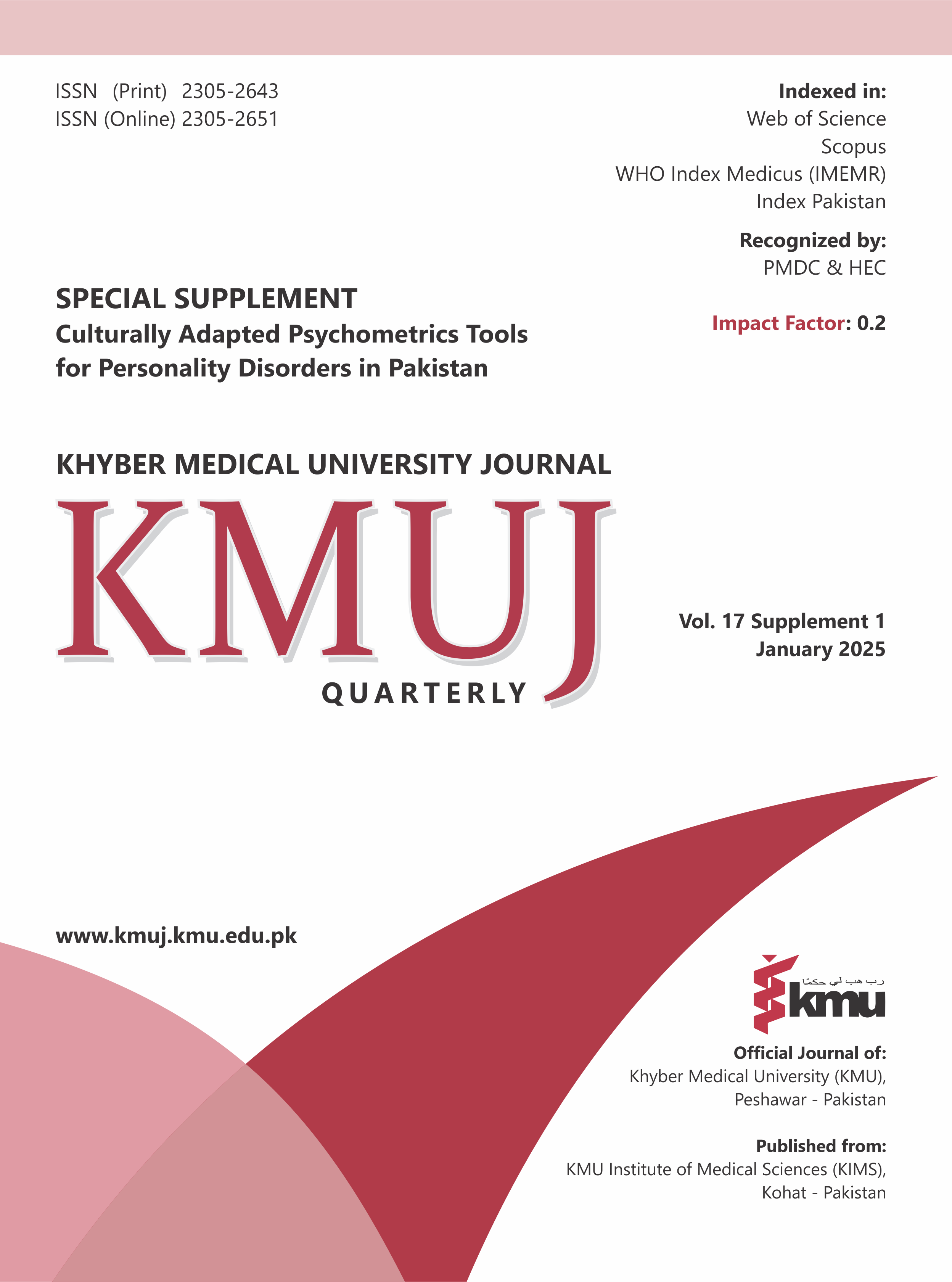Development and validation of an Urdu-language Schizotypal personality disorder scale: a psychometric analysis
Main Article Content
Abstract
Objective: To construct a valid measure of Schizotypal Personality Disorder Scale (STPDS) in Urdu language.
Methods: The cross-sectional analytic study, approved by Departmental Research Review Committee, University of Gujrat, was conducted from February to June 2019. In the initial phase, a 27-item STPDS was developed using standardized procedures, including exploratory and confirmatory factor analysis, from an initial pool of 80 items. Data were collected from 234 participants (males=123, females=111), aged ≥18 years, recruited through purposive sampling from clinical and non-clinical populations across educational institutes, hospitals, and communities in Gujrat, Pakistan. Participants provided informed consent and completed demographic forms and questionnaires. Ethical considerations, including voluntary participation, anonymity, and confidentiality, were maintained throughout the study.
Results: The Kaiser-Meyer-Olkin value was .929, and Bartlett’s test of sphericity was significant (p<.001), confirming sampling adequacy. Exploratory factor analysis identified 7 factors explaining 66.11% of the variance, with factor loadings ranging from .40 to .78. Confirmatory factor analysis yielded a good model fit (CMIN/DF=1.876; GFI=.855; CFI=.908; RMSEA=.061). A 27-item scale was finalized, demonstrating strong psychometric properties. Cronbach’s alpha for the STPDS was .941, indicating excellent reliability, while subscales ranged from .688 to .892. Convergent validity analysis with the Schizotypal Personality Questionnaire-Brief (SPQ-B) showed a moderate positive correlation (r=.454, p<.01).
Conclusion: The 27-item STPDS exhibited strong psychometric properties, including reliability and construct validity, and serves as a robust tool for assessing schizotypal personality disorder. The scale is suitable for use in clinical and non-clinical settings and may aid future research and diagnosis in this domain.
Article Details

This work is licensed under a Creative Commons Attribution 4.0 International License.
Work published in KMUJ is licensed under a
Creative Commons Attribution 4.0 License
Authors are permitted and encouraged to post their work online (e.g., in institutional repositories or on their website) prior to and during the submission process, as it can lead to productive exchanges, as well as earlier and greater citation of published work.
(e.g., in institutional repositories or on their website) prior to and during the submission process, as it can lead to productive exchanges, as well as earlier and greater citation of published work.
References
1. American Psychiatric Association. Diagnostic Statistical Manual for Mental Disorders. 5th ed. Arlington, V.A: American Psychiatric Publications 2013;669-71.
2. Battaglia M, Fossati A, Torgersen S, Bertella S, Bajo S, Maffei C, et al. A psychometric-genetic study of schizotypal disorder. Schizophr Res 1999;37(1):53-64. https://doi.org/10.1016/s0920-9964(98)00131-5
3. Rosell DR, Futterman SE, McMaster A, Siever LJ. Schizotypal personality disorder: a current review. Curr Psychiatry Rep 2014;16(7):452. https://doi.org/10.1007/s11920-014-0452-1
4. Raine A. Schizotypal personality: neurodevelopmental and psychosocial trajectories. Annu Rev Clin Psychol 2006;2:291-326.
5. McGlashan DA, Grilo CM, Shea MT, Yen S, Gunderson JG, Morey LC. et al. Ethnicity and four personality disorders. Compr Psychiatry 2003;44(6):483-91. https://doi.org/10.1016/s0010-440x(03)00104-4
6. Kirchner SK, Roeh A, Nolden J, Hasan A. Diagnosis and treatment of schizotypal personality disorder: evidence from a systematic review. NPJ Schizophr 2018;4(1):20. https://doi.org/10.1038/s41537-018-0062-8
7. Tay L, Jebb A. Scale Development. In: Rogelberg SG (editor), The SAGE Encyclopaedia of Industrial and Organizational Psychology. 2nd ed. 2017. SAGE Publications, New Delhi, India. https://doi.org/10.4135/9781483386874
8. Raine A.The SPQ: A scale for the assessment of schizotypal personality based on DSM-III-R criteria. Schizophr Bull 1991;17(4);555-64. https://doi.org/10.1093/schbul/17.4.555
9. Hogan R, Hogan J. Hogan development survey manual, second edition, 1997. Tulsa; OK; Hogan Assessment Systems. Last accessed on Feb 02, 2023. Avaialable from URL: https://www.crownedgrace.com/wp-content/uploads/2016/04/Hogan-Development-Survey.pdf
10. Peskin M, Raine A, Gao Y, Venables PH, Mednick SA. A developmental increase in allostatic load from ages 3 to 11 years is associated with increased schizotypal personality at age 23 years. Dev Psychopathol 2011;23(4):1059-68. https://doi.org/10.1017/s0954579411000496
11. McGlashan TH, Grilo CM, Skodol AE, Gunderson JG, Shea MT, Morey LC, et al. The collaborative longitudinal personality disorders study: baseline axis I/II and II/II diagnostic co-occurrence. Acta Psychiatr Scand 2000;102:256-64. https://doi.org/10.1034/j.1600-0447.2000.102004256.x
12. Kendler KS, Myers J, Torgersen S, Neale MC, Reichborn-Kjennerud T. The heritability of cluster A personality disorders assessed by both personal interview and questionnaire. Psychol Med 2007;37(5):655-65. https://doi.org/10.1017/s0033291706009755
13. Raine A, Benishay D. The SPQ-B: a brief screening instrument for schizotypal personality disorder. J Pers Disord 1995;9(4):346-55.
14. Edmundson M, Lynam DR, Miller JD, Gore WL, Widiger TA. A five-factor measure of schizotypal personality traits. Assessment 2011;18(3):321-34. https://doi.org/10.1177/1073191111408228
